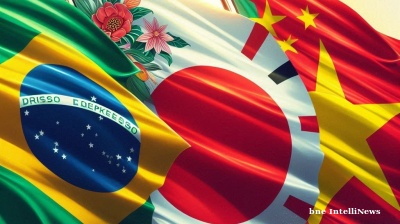Another brutal but underreported war is raging in a country that is perhaps not on people’s minds daily, but the civil war in Russia’s ally Myanmar is now in its fourth year.
It is, sadly, a familiar scenario for Southeast Asia. The Myanmar Armed Forces, or Tatmadaw, staged a military coup in February 2021 after their proxy party lost heavily in the 2020 election. It arrested the de facto civilian leader Aung San Suu Kyi and put lawmakers and other officials under house arrest, ending the democratic process that had been underway since 2008.
The following massive street protests that started peacefully were violently put down. The ousted elected lawmakers, protest leaders and ethnic groups organised in a parallel government, that later morphed into armed resistance, the ‘People’s Defence Force’. Separate ethnic armies fighting for their own autonomous states have joined the conflict. Fighting has been merciless ever since.
Relations between Moscow and the military junta of Myanmar have become stronger since the ‘21 coup and the ’22 Russian invasion of Ukraine. Russia was the only major power to recognise the new government after the overthrow of democracy and Myanmar was the only ASEAN nation to endorse the invasion of Ukraine, declaring it was necessary for Russia’s sovereignty.
Unsurprisingly, Moscow has accused Western countries of supporting the ‘extremist’ People’s Defence Force, with the goal of destabilising the situation and pursuing their neo-colonialist goals. Myanmar was a British colony until 1948.
Russian Foreign Minister Sergei Lavrov described Myanmar as a ‘friendly and long-standing partner’ in August 2022, and Vladimir Putin met junta leader Min Aung Hlaing a month later on the sidelines of the Eastern Economic Forum in Vladivostok. Min Aung Hlaing sycophantically called Putin a ‘leader of the world, controlling and organising stability globally’.
Russia is one of only a few other countries to supply the junta with weapons since the ’21 coup, the others primarily being China, North Korea and Belarus.
South Asian and Southeast Asian countries have been key defence markets for Moscow, with India (34%) and China (21%) being the main clients. But war and sanctions have caused an export slump, and it is now selling to 23 countries from 31 countries in 2019.
Myanmar sourced it arms mainly from China in the 1990s but also started to buy from Russia from this time to reduce its dependence on its neighbour. Sales include MIG’s and Sukhoi fighter jets that are now used to batter the Myanmar Resistance, but also missiles, tanks and technical training. Myanmar’s acquisition of Russian arms has overtaken China and India with 38% vs. 26% and 18% of total purchases respectively.
Ukraine has also supplied Myanmar with weapons since 2018, and some defence contractors, including state-owned, continued to do so after the coup took place, according to a report by activist group Justice for Myanmar, based on export data. As the junta blocked President Zelenskiy from speaking at an ASEAN summit in late 2022, we can assume that these contacts have ceased.
Russia has been buying back weapons they had already sold to countries including Myanmar and India, including tanks and missiles, as first reported by Nikkei news agency in 2023. Other sources report Myanmar-made 120mm mortar rounds are sold to Russia, and Russian technicians assist in the manufacturing process.
The Myanmar military junta has been on the backfoot for a year. It has been losing ground to the resistance groups and large areas of the country are now no longer under their control. In desperation a mandatory conscription was announced recently.
Russia has been doubling down on its support for the side that is desperately holding on to power and might be losing this civil war. Not only has Russia’s military planned joint exercises with the Tatmadaw, Moscow also plans to develop tourism between the countries and increase academic and cultural cooperation.
Denying reality on the ground, Moscow’s bet might be the junta’s downfall being a slow grind during which it might still benefit from military cooperation. Another scenario could be the junta winning the war against the odds if the coalition falls apart prematurely. Russia could then hold on to a key ally in Asia in a challenging time for its foreign policy.
Another scenario for Myanmar is it becoming a failed state if the coalition of ethnic armed groups falls apart after a defeat of the junta, internecine conflict ensues and Russia, having a foothold in the country, can sell weapons opportunistically to whichever group will buy.
Mark van Loon is a London-based writer with a focus on SE Asia.
Opinion

ING: Trump’s Tariffs - Europe’s worst economic nightmare just came true
A US 20% reciprocal tariff on the European Union will hurt. It's worsened the eurozone's short-term outlook. Now, so much depends on European governments to push through with their planned fiscal stimulus and reforms to strengthen domestic economies.

BEYOND THE BOSPOROS: Regime panicky over opposition call for “No shopping day”
English rock band Muse, meanwhile, scrap Istanbul concert in solidarity with Imamoglu protesters.

COMMENT: Brazil’s Lula builds economic bridges across the Pacific
Brazil's President Lula boosted ties with Japan and Vietnam during his Asian tour last week, securing aircraft deals, beef markets and partnerships.

COMMENT: South Caucasus offers a potential diplomatic triumph for Trump
The new US administration wants to become the political team that ends the longstanding conflict between Armenia and Azerbaijan.



